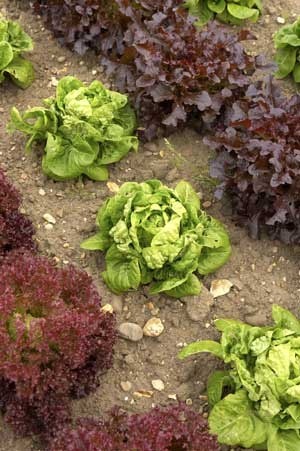
Late summer and early fall is the perfect time to squeeze a second season of vegetables out of your garden. For crops like corn, the warm days and cool nights of fall concentrate their sugars, which acts to enhance their flavor. For crops like spinach and lettuce, the cool weather prevents them from bolting prematurely and turning bitter. Depending on how long it takes your crop to mature and which growing zone you live in, there is still plenty of time to put in a second crop.
You don't need a designated vegetable garden to plant cool weather crops. Window boxes, empty containers or an empty space formerly taken up by this year's annuals will all work fine. To prepare soil for planting, clear away old plant debris and work some compost into the top few inches of the soil. If necessary, moisten the soil thoroughly a few days before planting to make it easier to work.
Although temperatures are starting to cool, this time of the year soil temperatures are higher and the moisture level in the soil is lower. In warmer zones, daytime heat can turn topsoil into a hard crust and high temperatures can prevent seeds from germinating. Seeds will need to be planted as much as two times deeper than normal to compensate for these "summer-like" conditions. If necessary, use row covers to help keep the soil cool and moist or sow your seeds in the shade of taller plants.
Shorter days and cooler temperatures slow down plant metabolic processes, so expect cool weather crops to take longer than normal to reach maturity. To figure out what to plant, read the back of your seed packets to find out how many days are needed to reach maturity. Now add another 2 weeks onto the projected number of days needed in order to make up for the reduced amount of available sunlight and the lower nighttime temperatures. For example, if radishes normally take 35-40 days, expect them to take 49-64 days. If you know your average first frost date, take a calendar and count backwards the number of days it takes your crop to mature. This is the approximate date to sow your seeds. If you don't know your average first frost date, contact your country extension agency.
Even if you live in a lower zone, there is still time to plant certain crops. Obviously, corn doesn't grow particularly well in the frost and snow. Still, don't automatically rule out a crop just because your first frost date is rapidly approaching. Spinach, for example, can be easily over wintered provided that it has reached a good size before the first hard frost and is given some protection. Some root crops, like turnips, carrots and rutabagas, can be covered with a deep layer of protective mulch as temperature drop and harvested from under several inches of snow in mid winter (providing you can get to them, of course). Try to select "early" variety cultivars and remember that row covers and cold frames offer gardeners the ability to extend the growing season well into fall.
Here are some examples of good second season crops:
| Vegetable | Approx. Days to Maturity |
| Beets | 55 to 60 |
| Broccoli | 70 to 80 |
| Brussels Sprouts | 90 to 100 |
| Cabbage (including Chinese) | 70 to 80 |
| Carrots | 85 to 95 |
| Cauliflower | 55 to 65 |
| Collards | 60 to 100 |
| Kale | 40 to 50 |
| Kohlrabi | 50 to 60 |
| Lettuce | 40 to 50 |
| Mustard | 30 to 40 |
| Onions (sets) | 60 to 80 |
| Peas | 55 to 70 |
| Radishes | 25 to 30 |
| Rutabaga | 70 to 80 |
| Spinach | 50 to 60 |
| Turnips | 55 to 60 |
No matter the season, vegetables require at least 1 inch of water per week and should never be allowed to dry out. Be aware that it's easier to over water crops in the fall, because as temperatures drop, the soil is able to hold moisture for longer periods of time.

About The Author: Ellen Brown is an environmental writer and photographer and the owner of Sustainable Media, an environmental media company that specializes in helping businesses and organizations promote eco-friendly products and services. Contact her on the web at http://www.sustainable-media.com
Add your voice! Click below to comment. ThriftyFun is powered by your wisdom!
O.K., I just might give corn another try on the back side of my garden this season, IF I GET TO IT IN TIME, based on your suggestion. I hope the rainy
season isn't floods instead, here in TX, so that
the corn won't rot. I will try to raise the bed this time and try to plant a better variety somehow. My cabbage and brussel sprouts are hanging on, living
Add your voice! Click below to comment. ThriftyFun is powered by your wisdom!